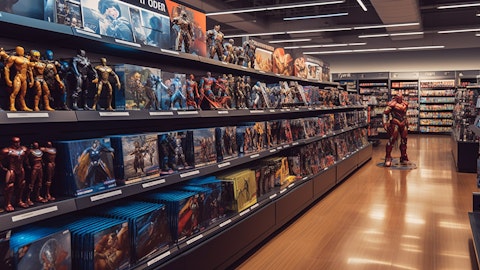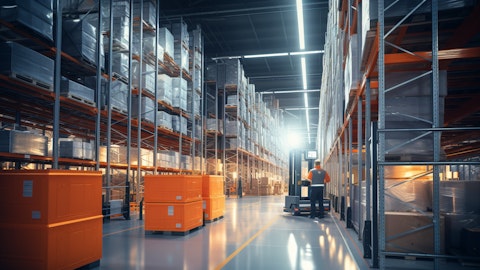AEye, Inc. (NASDAQ:LIDR) Q3 2025 Earnings Call Transcript November 6, 2025
AEye, Inc. beats earnings expectations. Reported EPS is $-0.17, expectations were $-0.19.
Operator: Ladies and gentlemen, thank you for standing by. At this time, I would like to welcome everyone to the AEye Q3 2025 Earnings Conference Call. [Operator Instructions] I would now like to turn the conference over to [ Jeremy Apple ]. You may begin.
Unknown Executive: Good afternoon, and thank you for joining AEye’s third quarter 2025 earnings call. With me today are Matt Fisch, Chief Executive Officer and Chairman; and Conor Tierney, Chief Financial Officer. Earlier today, AEye announced its financial results for the third quarter. A copy of this press release can be found on the Investor Relations section of the company’s website. Before we begin, I would like to remind participants that today’s discussion may include forward-looking statements as defined in the securities laws and regulations of the United States with reference to future events, operating results or financial performance, and such forward-looking statements are based on our current expectations and assumptions regarding our business, the industry and other conditions.
These forward-looking statements are subject to inherent risks, uncertainties and changes in circumstances that are difficult or impossible to predict. Our actual results may differ materially from those contemplated by these forward-looking statements. We caution you, therefore, against placing undue reliance on any of these forward-looking statements. You can find more information about the risks, uncertainties and other factors in the reports AEye files from time to time with the Securities and Exchange Commission, including in the most recent periodic report. The statements could be made are as of today only, and AEye does not intend to update any forward-looking statements regardless of any new information, future developments or otherwise, except as may be required by law.
In addition, we will be discussing non-GAAP financial measures on this call, which we believe are relevant in assessing the financial performance of the business. These measures are presented as supplemental information only and should not be considered a substitute for financial information presented in accordance with GAAP. You can find reconciliations of these metrics to the most directly comparable GAAP measures within the press release. Now I’ll pass the call over to Matt.
Matthew Fisch: Thanks, Jeremy, and thank you all for joining our third quarter 2025 earnings call. This quarter marked another step forward for AEye as we continue to build on the progress made over the past year. Over the last several quarters, we’ve executed the strategy that we set forth, brought spending under control, developed and launched a differentiated products ready for commercialization and established the foundation for scalable growth. Now with Apollo in the market and gaining traction, our focus has shifted to building and converting a strong revenue pipeline. We’re winning new customers, expanding partnerships and gearing up to scale Apollo. As we just announced, increased investor confidence in what we’ve been building has allowed us to secure the capital needed to ramp our production line.
With a strong cash position, providing visibility for the next few years, we are well positioned to translate momentum into sustained revenue growth. Further, Apollo’s unique combination of long-range sensing from behind the windshield, compact design, software-driven versatility and competitive pricing continues to resonate with customers, and we’re securing new contracts across our target markets. We believe no one else offers the same blend of performance and adaptability, which continues to fuel our commercial momentum. Today, we want to focus on sharing details around our progress towards revenue growth via commercialization of Apollo and OPTIS. I’ll start with where we’re seeing the most momentum right now, our growing customer base and the real-world programs that are putting Apollo to work.
We doubled our customer base since the end of the second quarter, bringing us to 12 customer contracts signed year-to-date. One of those wins came from a global defense contractor using Apollo on UAVs to improve wire detection, a perfect example of Apollo’s strength in identifying small objects at long-range and high speed. These kind of programs not only create near-term revenue opportunities, but also open the door to broader adoption across defense and aerospace OEMs. Our commercial pipeline also continued to strengthen in Q3 with 2 dozen active quotes tripling last quarter’s level. The pull from customers is real, and we’re converting more opportunities into active programs. The pipeline is deepening, giving us better visibility to future revenue and a solid base to build from as we grow.
Across these programs, interest is growing rapidly in Physical AI, a concept focused on bringing vision to intelligence. Put another way, this is the equivalent of giving eyes to an [ AI ] model like ChatGPT. We’re already seeing this come to life through real deployments, including the UAV wire detection application I just mentioned as well as optical detection for rail and waystation automation powered by OPTIS Analytics. Together, these programs show how Apollo and OPTIS are enabling intelligent perception in challenging environments, while we continue to drive expanded engagement with automotive OEMs who value Apollo’s long-range behind the windshield visibility. Next, I’ll touch on our expanding manufacturing capacity. As I mentioned earlier, we’ve announced an expansion of the agreement with our Tier 1 manufacturing partner, LITEON, and an investment from a leading global institutional investor to fund a new dedicated production line for Apollo with capacity to produce up to 60,000 units annually.
We’re seeing an inflection point in customer demand, and this expansion ensures we can meet the growth head on. Our capital-light model allows us to channel investment directly into working capital for production rather than fixed infrastructure, enabling rapid and efficient scaling. This decision reflects our conviction in Apollo’s commercial momentum and positions us to capture the accelerating demand ahead. In addition, recent developments in the lidar industry have validated and reinforced our conviction that our capital-light model is the most viable path to sustainable commercialization. Turning to markets and partnerships. Engagement with the automotive industry remains strong with active discussions underway with about 2/3 of major Western OEMs. What’s capturing their attention is Apollo’s compact design.
It sits cleanly behind the windshield without compromising long-range performance, giving OEMs a vehicle packaging solution for meeting hands-off, eyes-off sensing requirements that doesn’t require exterior vehicle modifications. We believe that this packaging advantage provides AEye with a key differentiator as the next generation of programs are sourced. As automotive programs progress, we forged critical software partnerships that are opening new markets and already translating into sale across defense, aviation, rail and smart infrastructure. These collaborations are helping us mature Apollo, enhance cost efficiency and expand adoption. Recent examples include partnerships with Blue-Band, which uses Apollo’s long-range sensing for [ AI-driven ] traffic management and Flasheye, whose 3D perception software enhances safety and logistics applications in complex scenarios such as at airports and transportation hubs.
Internationally, our partnership with Black Sesame Technologies in China combines Apollo’s 1550-nanometer sensor with their automotive-grade compute platform to deliver a full stack obstacle detection capability. This solution has already been selected by a leading transportation OEM, representing a potential multimillion-dollar revenue opportunity and underscoring Apollo’s performance, reliability and scalability in one of the world’s most competitive mobility market. Together, these partnerships are turning opportunity into action, driving real Apollo and OPTIS sales today. In closing, we’re executing with focus and delivering results. Apollo’s clear differentiation is driving real sales and strengthening our customer base and our strategic partnerships are translating into commercial wins.

We’re adding customers, broadening our market reach and scaling production alongside partners who share our vision, backed by a strong cash position that gives us a clear path to execute our plans for growth in the coming years. We have the resources and flexibility to advance commercialization. The pieces are in place. We have the technology, the partnerships and the balance sheet to continue this progress and drive consistent revenue expansion. I’ll now turn the call over to Conor to review our financial performance.
Conor Tierney: Thanks, Matt. AEye is demonstrating solid financial discipline and operational resilience, positioning the company for durable long-term growth. With $84 million in cash at the end of Q3, we have the runway to operate well into 2028, providing a solid foundation to scale and execute our growth strategy with confidence. Importantly, we have cleaned up our capital and debt structure, leaving us in a stronger financial position compared to our peers. We’re approaching growth in 3 deliberate phases, each designed to unlock value and build momentum. This is a disciplined road map, not just for the next quarter, but for the next several years. Phase 1 is laying the foundation and gaining traction, and we’re already seeing solid progress here.
Strategic partnerships are taking shape, particularly in nonautomotive markets and proof-of-concept deployments are validating our technology in real-world scenarios. These early wins are critical because they set the stage for everything that follows. Phase 2 is where we accelerate, and we expect the inflection point for this phase to come next year. To prepare, we’re putting in place the infrastructure we need, strengthening our supply chain, expanding manufacturing capabilities and building deployment readiness so we can meet the demand we anticipate. This is when revenue should begin to climb and margins turn positive as we optimize costs and streamline operations. It’s the bridge from promise to performance. Phase 3 is the breakthrough moment when profitability becomes real.
Each phase builds on the last, creating a clear path to unlock adoption, drive revenue and ultimately create shareholder value. It’s a disciplined approach to scaling with confidence. As Matt noted, our commercial pipeline continues to expand at an impressive pace. In fact, our nonautomotive funnel has grown sixfold from fewer than 100 prospects earlier this year to nearly 600 today. Quarter-over-quarter technical engagements increased by nearly 50%. Quotes issued tripled and signed contracts doubled to 12 since Q2. These metrics tell a clear story. We’re seeing stronger alignment with customer needs and growing confidence in our technology. Intelligent Transportation Systems lead the way in funnel volume and proof-of-concept activity, while rail shows some of the highest engagement rates.
Aerospace and defense are also maturing nicely. What’s driving this traction, it’s Apollo’s unique value proposition. Combining powerful lidar capabilities with flexible software control and a compact design, Apollo fits seamlessly behind the windshield for streamlined automotive integration. This flexibility allows us to tailor solutions for specific applications and lead in sectors where alternatives appear limited, creating a distinct competitive advantage that strongly resonates with customers. OPTIS is moving our partnership strategy forward. We’ve moved OPTIS from concept to structured offering with initial deployments already completed. Now we’re enhancing system performance by adding compute and perception capabilities. At the same time, we’re expanding our ecosystem beyond perception-only solutions, engaging in technical discussions with new partners and exploring reseller opportunities to extend our reach.
Recent additions to our partner network include Black Sesame, Blue-Band and Flasheye. I’ll now move on to Slide 7 to address our cash burn and our capital-light model. Excluding net financing proceeds, third quarter cash burn decreased by approximately $0.7 million to $6.4 million. This reduction follows an elevated burn rate in the second quarter, which included a onetime $1.4 million lease settlement payment, partially offset in the third quarter by higher engineering and professional service costs. Our capital-light model remains instrumental to our growth strategy, allowing us to expand efficiently by leveraging strategic partnerships rather than making heavy capital investments in manufacturing our software infrastructure. As shown on this slide, our unique operating model translates into meaningfully lower expenses compared to peers, providing a distinct advantage in capital efficiency as we continue to scale.
Now turning to our third quarter financial results on Slide 8. Third quarter GAAP operating expenses were $7.8 million, down from $8.6 million in the second quarter of 2025, primarily due to lower costs associated with our proxy contest, personnel expenses and contract development costs. Third quarter non-GAAP operating expenses were $6.1 million, a decrease of $0.7 million compared to the prior quarter, primarily driven by the same cost drivers as described above. We reported a GAAP net loss of $9.3 million or $0.30 per share in the third quarter, which was comparable to the GAAP net loss of $9.3 million or $0.48 per share in the second quarter of 2025. On a non-GAAP basis, our net loss was $5.4 million or $0.17 per share, beating consensus estimates in the third quarter compared to a non-GAAP net loss of $6.7 million or $0.35 per share in the prior quarter.
This improvement was driven primarily by operating expense reductions noted above and increased interest and investment income. Net cash used for operating activities decreased to $6.1 million in the third quarter from $6.4 million in the second quarter of 2025. We ended the quarter with cash, cash equivalents and marketable securities of $84.3 million, more than quadruple our cash balance compared to prior quarter end. Since quarter end, we’ve raised an additional $10 million. Importantly, we remain focused on maintaining a strong, simplified balance sheet. The convertible note executed earlier this year has been fully repaid. And during the quarter, we eliminated legacy warrants, further cleaning up our capital structure. These actions position us in a much healthier financial state compared to many peers in the sector who continue to carry significant debt.
Overall, we’re maintaining strong liquidity, disciplined capital management and a balance sheet that supports our long-term growth strategy. Moving on to our cash burn outlook on Slide 9. We continue to expect full year 2025 cash burn to be at the high end of our previously communicated range of $27 million to $29 million, reflecting planned investments to scale Apollo production and support commercial expansion. In summary, we’re thrilled by the momentum that we are seeing across the business. Apollo’s differentiated value proposition is strengthening our customer pipeline, while we continue to have the most efficient cost structure among our peers. Financial discipline remains our top priority as we look ahead to scaling to meet growing demand for our advanced lidar technology.
With that, I’ll pass it back to Matt to wrap things up.
Matthew Fisch: Thanks, Conor. We’re proud of the progress AEye has made, both technically and commercially this quarter. Sales are ramping and our pipeline is accelerating as we see rapidly increasing pull from the market, strong leading indicators of the revenue growth we expect in 2026. The team is fully aligned around execution, and we look forward to updating you on our continued progress in the quarters ahead.
Q&A Session
Follow Aeye Inc. (NASDAQ:LIDR)
Follow Aeye Inc. (NASDAQ:LIDR)
Receive real-time insider trading and news alerts
Operator: [Operator Instructions] Our first question comes from Poe Fratt from Alliance Global Partners.
Charles Fratt: Congratulations on the progress. Would — Matt, would you expand on your confidence in the capital-light model, especially in the context of recent industry events?
Matthew Fisch: Poe, yes, sure, happy to do that, and thanks for joining us again this quarter. I think there’s 2 pieces to think about here. One is what I’d call the more obvious piece, which is manufacturing capital investment. And then the second — I do want to talk about software a bit because that’s important as well. We’ve got — our capital-light model on the manufacturing side relies on a partnership with LITEON who has a very global footprint and also very importantly, they’re experienced in dealing with the automotive industry. Just to give you an example, I’m out here in Detroit today, I was meeting with an OEM talking about our progress in their supplier audit process. OEMs are now starting to use a word called resiliency, which means can you quickly change your manufacturing site from one part of the world to the other?
And as a small company, that’s incredibly expensive to be able to invest in something like that. And our capital-light model says we partner with somebody is very seasoned and experienced in this area. So we can have this flexibility, nimbleness and resiliency through our partner as opposed to having to make massive investments. And this allows us to essentially look at just-in-time delivery, ordering of components. So we’re really focused on looking at the pull from the market and then ensuring that our working capital is lined up and ready for just-in-time delivery. And that keeps our upfront costs incredibly low. This also extends to our focus in the software space as well. We just want to be great at building best-in-class lidar, and we’re also very adept at helping customers solve particular problems.
With this capital-light model, we rely on partners to write perception software, for example. That’s a big expense to create perception software and maintain it. And we’re happy to offer that through our OPTIS platform through our partners, again, avoiding the upfront investment of having to build the software ourselves. And I think the results speak for themselves. I mean the cash balance in the company is very strong. Our debt structure is very strong, and we’re able to basically manage that through just-in-time delivery, thanks to our capital-light model.
Charles Fratt: That’s great color. And then can you look at — there’s a big jump. You doubled your customer base to 12. Can you just talk more about that pipeline of customers? And within the 12 customers now, can you talk about the mix between auto and non-auto?
Conor Tierney: Poe, this is Conor here. I can jump in for that question, and then maybe Matt can add his thoughts at the end. But first off, addressing this question, I’d just like to preface it with the fact that we’ve really only had Apollo out in the market and in customers’ hands since early in the year. We’re talking February time frame. So I think the amount of traction that we’ve shown on the funnel is just amazing, in my opinion. So if you look — just referring back to the script, if you look at the number of prospects that we have in the funnel, we’ve increased that from 100 at the beginning of the year to almost 600 today. If you look further down the funnel, if you look at technical engagements that we have with customers, that’s increased by almost 50%.
If you look at quoted activity, that’s almost tripled. And then as you alluded to just now, we’ve seen a lot of traction on the contract side as well. We’ve grown that, almost doubled it from 6 to 12 in just 1 quarter. And so when I think about that, there’s a certain amount of commonality with the customers that are engaging with us. And what we’re seeing is there is a appetite for high-performance sensors. And so the value prop that we’re bringing is quite unique in the marketplace right now. It’s a combination of long-range, we can see up to a kilometer, but also ultra-high resolution as well. And the software reconfigurability piece is something that really resonates because you think about each customer, they have unique use cases. And so that adaptability, being able to work with the customer, being able to customize a solution that works for them is something that’s very compelling to the end customer.
And that’s really the value prop. And then the other thing, just thinking about the market, up to now, if you think about those high-performance sectors, Matt alluded to it in his script, you’re talking about defense, you’re talking about smart infrastructure, rail. You think about — especially in the defense sector, you think about the solutions that have been on the market for the last 30 years, high-performance lidar sensors we’re selling for even millions of dollars, right? And then you think of other sensor modalities such as radar and camera, there was some limitations and deficiencies in those solutions. So what we’re offering right now is really a high-performance sensor at a really competitive price point. And I think that’s really compelling to the end user.
And that’s why we’re seeing a lot of growth in the funnel, a healthy conversion rate, right, moving from 2 customers at the beginning of the year to almost 12 today. That’s a really strong signal that customers are engaged and they’re interested in what we’re doing. So Matt, I’m not sure if you want to chime in or if you have anything else to add there.
Matthew Fisch: Yes. Well said, Conor. I think I’d just add one thing, and that is talking about the automotive space, you may think, well, why does a passenger vehicle need a 1 kilometer range. What we’re bringing into that space in the same small size and low-cost package is the ability to put the lidar inside the cabin behind the windshield. Glass does terrible things to lidar, and you can’t see very far or when you try to shine the lidar through glass. This 1 kilometer performance allows us to meet the automotive and passenger vehicle requirements through the windshield inside the cabin. And that’s getting us a lot of meetings with OEMs right now. They’re very interested in avoiding that bump on the roof, the taxi sign, so to speak.
So it’s not just sort of the defense and other industries that if you look at a kilometer, wow, that’s amazing. We need to have that. Shining the lidar through the glass in the vehicle through the windshield greatly simplifies the OEM lidar integration problem. So we’re getting a lot of interest on the automotive side from that perspective as well.
Operator: Our next question comes from Casey Ryan from WestPark Capital.
Casey Ryan: Matt, Conor, lots of progress, great update here. There’s a lot to look at. I just wanted to ask, Matt, you used, I think, the more technical appropriate term of UAV as the defense opportunity. Is it fair to say that, that covers all drone applications potentially within defense? But then my question is, have you also seen an uptick or more interest from commercial drone manufacturers, particularly domestic as I know DJI is under review and there’s a potential loss of them from the market. So presumably, other people are stepping up now at this point.
Matthew Fisch: Conor, I’m going to have you jump in on that since you’ve been directly involved in those conversations.
Conor Tierney: Yes. Casey, just starting with the, I guess, the defense piece first. We are seeing interest in the UAV space, but it’s not just UAV, it’s also manned aerial vehicles as well. So it’s not just the drone piece. I would say, yes, there is an opportunity on the commercial side. That’s something that we’re actively pursuing. And if you think about drones are used for all sorts of use cases, obviously, disaster mitigation, aerial mapping, all those kinds of things. And I think the same attributes that attract DoD customers to us apply to all those use cases as well, right? These guys are looking for a solution that can see long-range, but also see with a high degree of resolution as well. So I would say we’re actively engaged across the board in all those sectors.
Casey Ryan: Okay. Tremendous. And then quickly, on the auto OEM side for mass market, which I realize we’re still some years away from, where do you sense the focus is? Are OEMs building for Level 3 and Level 4? Or are they still kind of trying to optimize for Level 2 and sort of hands-free type applications?
Matthew Fisch: Yes. Thanks, Casey. By the way, welcome back. Thanks for joining us. I’ll take that one. Look, it’s — I’m not necessarily going to speak on behalf of the OEMs. But in terms of the specs that are coming to us through RFIs, I would say that in the last 6 months, we’ve seen a significant shift into the L3 and L4 states. I think you can track some of that in the media as well. But if you look at the requirements that are coming in these RFIs from the OEMs, I think we’re seeing that shift to L3 and L4 very clearly in the last 6 months, I would say.
Casey Ryan: Okay. Terrific. Well, it’s helpful, and it’s a great update.
Operator: [Operator Instructions] Our next question comes from Poe Fratt from Alliance Global Partners.
Charles Fratt: Conor, would you mind just giving us a little more detail or a little more color on the institutional investor that you’ve lined up. Can you frame maybe the potential size of their investment and also the timing of the investment? And also, is that required to get to full production, that full production number of 60,000 units per year by the middle of next year?
Conor Tierney: Casey, let me — I’m sorry, [ not Casey ], Poe, let me address that. What I would say is we haven’t really released all those details or all those — that information in the PR, but I’ll try to at least address some of it. So it’s a well-known institutional investor. That’s for sure. The name will definitely resonate with everybody. What I would say is the investment itself was made after quarter end. So it’s part of that $10 million that I alluded to in the script. In terms of giving us enough runway, what I would say is we had $84 million in cash at the end of the quarter. When you take into consideration the additional capital that we raised post quarter end, we’re up above $90 million at this point. And we feel at this point in time that that’s more than enough capital to go out and execute to our growth — to basically go out and execute and accelerate our go-to-market strategy.
There could be opportunities to raise capital down the road, but I think we would have to carefully evaluate those opportunities. But at this point in time, I think we’re generally feeling relatively comfortable that we have enough capital at least for the immediate strategy that we’re pursuing here.
Operator: Our next question comes from Richard Shannon from Craig-Hallum Capital Group.
Richard Shannon: Apologize for the ambient noise here. I’m trying to watch my daughter’s volume [ off, turning up here ] at the same time. I may have missed the prepared remarks to this topic here, but the 6 new wins you talked about in the quarter here. Can you describe the applications and volume opportunity that you’re looking at here?
Matthew Fisch: Conor, why don’t you go ahead and take that one?
Conor Tierney: Yes. Richard, I can just give you a general idea about what those use cases relate to. As I said earlier, they’re for high-performance use cases. But generally, think about the aviation sector, rail [indiscernible] systems. And so what I would say is right now in Phase 1 of a 3-phase process. And so this is really foundational. So we’re working with the customers basically to put proof of concepts together. And that’s part of that overall strategy. So it’s really laying the foundations for a volume ramp that we expect to [ get ]. And indeed, we’re really getting very positive indications from customers that they’re willing to sign up for higher volumes. And that’s indeed why we made the decision with LITEON to invest in infrastructure and invest in the line, so we have the capacity to meet that demand when it does come through.
Richard Shannon: And maybe just a follow-up, Conor, what are we talking about in terms of the investments you’re — that you’re going to be making here with LITEON? I assume this is in the form of some CapEx is being conferred to them or whatever. But maybe you can just help us understand what that investment is and the magnitude of it over what time?
Conor Tierney: Yes. Look, what I would say is we don’t expect a dramatic increase in our burn rate next year. And I frame this from the point of view that if you look at our burn rate for this year, we’re guiding to about $29 million, but there’s a lot of onetime items included in that. So if you look at our baseline burn for this year, it’s really more like $25 million. So I would say probably at a minimum next year, we’re looking at around $30 million. There’s obviously the opportunity for that to go up a little bit if we invest in working capital. But for us, I mean, what we’re really looking at is gating some of the investment to specific milestones and specific commitments on the customer side. But the great thing is that we’re working with a partner that’s extremely flexible. And the upfront capital might come in the form of long lead commitments that we need to make, but we think we can be very flexible in that regard and gate spending to guaranteed demand.
Richard Shannon: A question, I’ll jump on the line here. You talked about investing in capacity of 60,000 units annually here. Do you have any visibility on the time frame by which you might be approaching high utilization with that kind of a unit volume here? I assume it’s not in the next year or 2, but if it is, I’d certainly love to get some context on that.
Conor Tierney: I don’t think that’s going to come overnight. I think it’s going to be more sequence, going to be more phased. But the important thing is to be ready, right, and to have that flexibility, and that’s why we want to work with a partner like LITEON. And what I would say is there’s some upfront investments, like I mentioned earlier, right? We’re going to probably have to make investments in working capital. There may be a little bit of CapEx. But because of our capital-light model, we’re able to keep those investments flow. And we’re getting a lot of support from Apollo as well in that regard too.
Operator: That concludes the question-and-answer session. I would now like to turn the call over to Matt Fisch for closing remarks.
Matthew Fisch: Thank you all for your time today. We appreciate your continued support and confidence in our vision. Have a great day.
Operator: This concludes today’s conference call. You may now disconnect.
Follow Aeye Inc. (NASDAQ:LIDR)
Follow Aeye Inc. (NASDAQ:LIDR)
Receive real-time insider trading and news alerts





